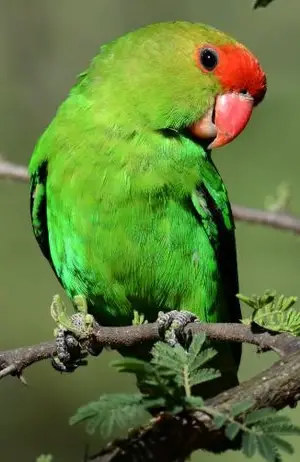Summary
The name Lovebird stems from these parrots' strong, monogamous pair bonding and the long periods of time in which paired birds will spend sat beside one another.
Lovebirds live in small flocks and eat mainly fruit, vegetables, some grasses and seed. Abyssinian Lovebirds also eat insects and figs, and the Black-collared Lovebirds have a special dietary requirement for native figs making them almost impossible to keep in captivity. Lovebirds (in general) are not known for their talking ability, although there are some lovebirds that do learn words - the females are usually the ones that do this. As is the case when many smaller parrots, the "voice" of lovebirds is high-pitched and raspy and it may be difficult to understand their speech. Lovebirds are very vocal birds, making loud, high-pitched noises that can be a nuisance. They make noise all day, but especially at certain times of day. They are also extremely active, and love to chew things. It is wise to observe the birds carefully when let out of their cage, and to protect any furniture, or anything they have access to.
Lovebirds are notorious for attempting to build nests, especially during mating season - for this reason, loose material such as shredded paper and fabric do not make suitable toys at certain times of year, as the lovebirds could see it as nest-making material and attempt to mate. Breeding is not something that should be attempted by someone without lots of experience. "Huts" or hiding places and small enclosures are also not good for the same reason.
Female lovebirds are prone to egg-binding, an often fatal condition in which an egg cannot be laid as it gets caught in the reproductive tract. It is thought that egg binding often occurs due to a lack of liquid calcium in the diet, which causes a softer shell. To prevent this females, particularly those kept in pairs, should be given calcium supplementation in their water from a young age. Additionally, egg binding appears more likely amongst younger birds; to avoid egg binding females in captivity should be prevented from engaging in mating behaviors until at least one year of age.
Lovebirds are also known to be nippy and bossy. Although this can be seen as amusing and endearing by many owners, some do not like it; a lovebird, while a nice pet, is not for everyone. They bite very hard and love to test their limits - if the owner does not set them early on, he or she will have a bird that bites to get their way.
Some species of the genus are amongst the most popular parrots kept as pets, and several color mutations have been selectively breed in aviculture. Their average lifespan is 10 to 15 years.
Lovebirds vary in size from about 13 to 17 centimeters in length and from about 40 to 60 grams in weight. They are among the smallest parrots in the world, and they are characterized by a stocky build, a short blunt tail, and a relatively large beak for their overall size.
Wild-type lovebirds are mostly green with a variety of colors on their upper body depending on the species. The Fischer's Lovebird, Black-cheeked Lovebird, and the Masked Lovebirds have a white ring around their eyes. The Abyssinian Lovebird, the Madagascar Lovebird, and the Red-faced Lovebird are sexually dimorphic. Many color mutations have been produced by selective breeding in the species that are popular in aviculture.






